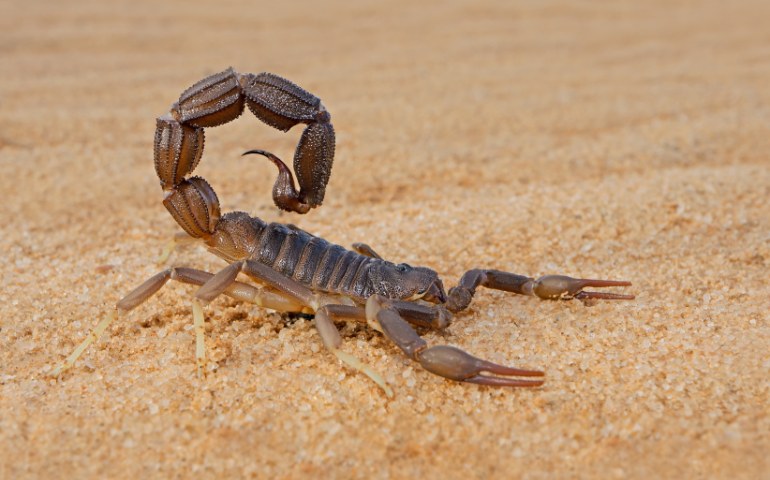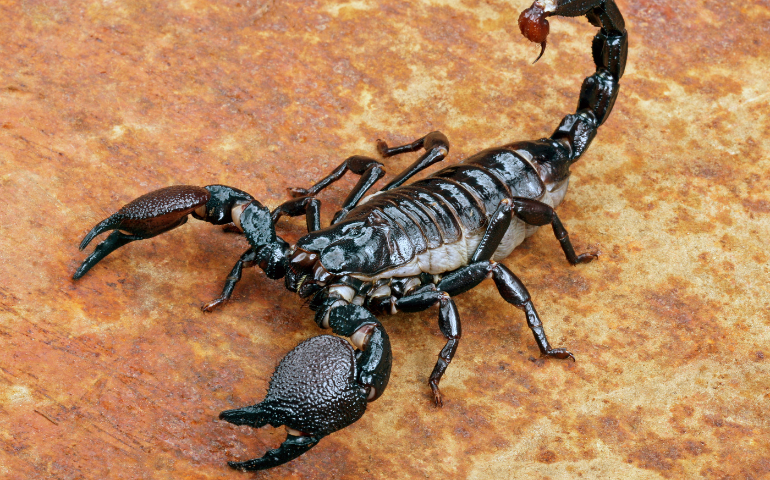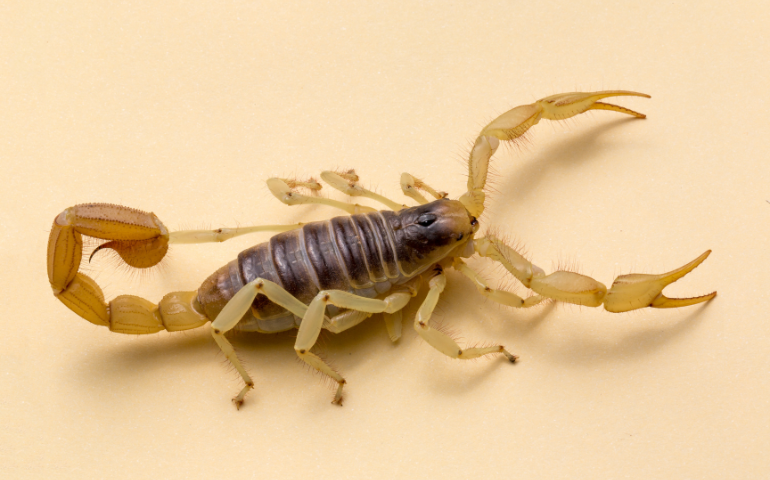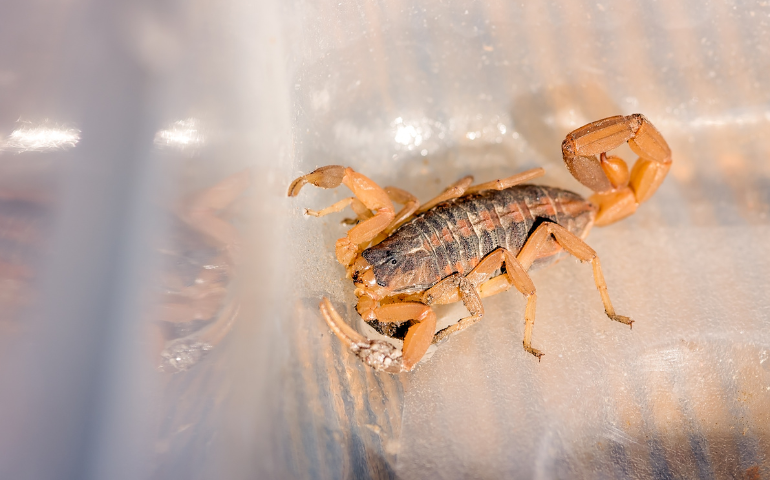What are Scorpions?
Scorpions are arachnids, which means that all adult scorpions have eight legs. To help retain moisture, this species of scorpion has waxy cuticles that cover its body. The cuticle glows under ultraviolet light.
Bark scorpions are yellow-colored or tan with two black stripes along their abdomens. They can grow up to 2 to 3 inches in length, most of them reaching 2-3/8 inches. Their tails are segmented and curve over their backs. The last segment is venom-filled with a stinger. They have a narrower tail than any other scorpion species. Their claws are used to capture and keep their prey.
What Kinds of Scorpions Are There?

The largest scorpion species in North America, the Desert Hairy Scorpion has a brown body with yellowish legs and pincers. Its name comes from the fine hairs that cover its body and legs, helping it sense vibrations in the desert environment. Preferring sandy and rocky areas, it burrows deep into the ground. While its sting is mild, it can still cause pain and swelling.

Known for its dark, almost black coloration, this scorpion is typically found in the desert regions. It has a robust build with large pincers and a sting that can cause moderate pain. The Black Scorpion prefers burrowing in sandy or rocky soils.

A small, yellowish-tan scorpion known for its slender body and curled tail, the Arizona Bark Scorpion is one of the most venomous scorpions in North America. Found in dry, rocky areas and around homes, its sting can cause severe pain and requires medical attention.

This species is easily recognized by the two dark stripes running along its back. Typically yellowish or light brown, the Striped Bark Scorpion prefers dry regions and is commonly found under rocks or logs. Its sting, while painful, is usually not life-threatening.
It’s important to note that scorpion stings can vary in severity depending on factors such as the species, the size of the scorpion, and the individual’s health. Most scorpion stings in the United States result in localized pain, redness, and swelling. However, individuals with allergies or other health concerns may experience more severe reactions.
To minimize the risk of scorpion stings, especially in regions where they are prevalent, it’s advisable to take precautions such as shaking out clothing and shoes before putting them on, using caution when reaching into dark or hidden spaces, and implementing pest control measures to reduce scorpion populations around homes. If someone is stung by a scorpion and experiences severe symptoms, they should seek medical attention promptly.

Behavior and Habitat
Bites
Most scorpion concerns are caused by the sting (which can contain venom) and not an actual bite. With one exception, scorpion venom is not considered a serious medical risk in the United States. A scorpion’s poison can cause swelling around the spot of the sting. Some people may experience convulsions and numbness. Some people may have difficulty breathing in extreme cases. A dangerous scorpion’s poison venom can cause severe allergic reactions, which increases the risk of death. If they are given antivenom to counteract the effects of the scorpion venom, their chances of survival increase.
Habitat
Scorpions can live in extremely dry environments. Scorpions are sensitive to moisture loss and will hide in shaded areas during the day. They get most of their water from their prey.
Stings
Scorpions use their stingers to catch prey and defend themselves. They hunt at night, and they will only sting when threatened or provoked. They use their stings to defend themselves or incapacitate prey. The scorpion species will vary in the effectiveness of their stings for humans. All scorpions share one thing in common: the sting contains venom. This is usually neurotoxic.
Do Scorpions Bite or Sting?
Scorpions do not bite, they only sting. A sting is often described by people using the term “bite”.
How to Identify the Sting
How does a scorpion sting look? Scorpion stings are usually easily identified by seeing the scorpion sting someone or looking around for scorpions trying to escape after being sting.
Stings: What are the Symptoms?
The majority of scorpion stings in the United States cause minor symptoms, such as redness, pain, and warmth at the site. The venom from the bark scorpion can be fatal for anyone who is sensitive, especially children.
The most common scorpion sting symptoms include mild pain, tingling, and swelling around the sting area. Other symptoms include muscle twitching and unusual head, neck, and eye movements, drooling or vomiting, high blood pressure (hypertension), hypotension (low blood pressure), accelerated heart beat, restlessness, excitability, and other severe symptoms. Stings can be painful or burning and cause small, sensitive swellings. Bark Scorpion stings can cause tingling or numbness, blurry vision, twitching and tingling. Hyperactivity and erratic eyes movement may be symptoms in children.
Treatment
The majority of scorpion species found in the United States are not considered to be highly venomous. However, Centruroides sculptureatus, an Arizona bark scorpion, is. Although they can be painful, most of the stings from North American scorpions are not serious and do not require any medical attention.
Specialists can place the affected area below the heart. This prevents the poison from spreading further and delays its absorption. To limit the spread of the poison, it is important to calm the patient and lower blood pressure.
If not treated properly, envenomization (the process of injecting poison by biting) by the Arizona bark scorpion can cause death. Anascorp is approved to treat scorpion stings, but you should check with your doctor.
Anatomy
The anatomy of a scorpion is made up two parts, the cephalothorax and the abdomen/opisthosoma. The cephalothorax is protected by the carapace, a hard and bony outer cover. This covers a pair median eyes in the top center.
Cephalothorax consists of the head, which includes the carapace and the eyes. It also contains the pedipalps (or the claws), and four pairs walking legs. These claws are the most important part of the scorpion. They are used to capture prey and protect against predators.
The opisthosoma (or abdomen) is divided into two parts: the mesosoma or metasoma. The metasoma is five and the mesosoma seven.
Six segments make up the mesosoma. This is the front portion of the abdomen. The first is the sexual organs. This includes a pair vestigial and modified appsendages, which form the structure known as the genital operculum. The pectines is the second sensory organ, which looks like a feather. Each pair of lungs is contained in the last four segments. The mesosoma is protected by tergites. These are a chitinous, upper-surfaced plates, and the sternites lower-surfaced plates.
The tail is located on the other side of the abdomen. Six segments make up the tail, with the anus and stinger in the last. The telson is equipped with a vesicle that in turn contains a pair venom glands as well as the hypodermic aculeus or barb. Two tails is a genetic abnormality in scorpions.
The scorpion’s cuticle is a tough, protective armor that surrounds its body. It is covered in hairs that act as balancing organs.
Reproduction and the Life Cycle
Female scorpions keep their eggs in their bodies. The young scorpions climb onto their mother’s back when they leave the female’s body. They remain on the mother’s side until they go through their first molt. They then get up and go.
Adult scorpions look a lot like small scorpions. As they age, their exoskeletons are shed. The molting stage is the most important part of a young scorpion’s development. It takes five to seven molts for them to reach maturity.
Scorpions love dry and warm habitats. They seek shelter in underground holes and undersides of rocks during the day.
When they’re old enough to hunt and eat, Scorpions turn nocturnal. They can invade the homes of predators such as birds, centipedes and lizards. They use their chelae (or pincers) to crush or inject prey with neurotoxic poison. This can paralyze or kill their prey. For eating, they use small claw-like structures protruding from their mouths. Scorpions will only eat liquids and dispose of solid matter after eating.
Lifespan
The lifespan of a scorpion is between 3 and 5 years. However, some scorpions can live as long as 10 to 15 years.
Life Cycle Stages
The scorpion lifespan varies according to the species. It always starts when the male and the female mate in fall or early spring. The majority of species begin the cycle by reproducing sexually through a series actions that involve an interesting ritual.
Reproduction
Male scorpions use chemical attractants known as pheromones to get their attention. They also emit focused vibrations.
The male uses his pedipalps to grab the female’s pedipalps when he finds her. They then “dance” while holding on to each other. They then follow the male to where he deposits their sperm.
The sperm is found in a structure known as a spermatophore. The sperm is drawn into the female’s genital pore by contact with it. The mating process can take up to 24 hours for some species.
Although it is rare in scorpions sexual cannibalism can occasionally occur. When mating has ended, the male will quickly leave the female.
Eggs
The female’s body produces fertilized eggs. The gestation period can vary depending on the species. It may take several months or even one year, depending on how long it takes.
Nymphs
The young look just like their parents when they are born. The nymphal stage scorpions are soon able to climb onto their mother’s back shortly after they are born. They will stay there until their first moult.
Development
The nymphs scatter after the first molt occurs, approximately two weeks after the birth. The scorpions molt approximately five to six times during their entire life cycle before reaching maturity.
scorpions are slow to develop, but they live longer than spiders and insects. Most scorpions live between three and five years. However, some can live up to ten years.
Scorpion Species
There are currently 1,200 species of scorpions known to exist in the world. All of these scorpions can be dangerous. The smaller scorpions are more dangerous than the larger ones. However, larger scorpions can be more intimidating to potential predators.
The Arizona bark scorpion ( Centruroides sculpturatus) is one of the most notorious scorpion species in the American Southwest. Although deaths have been reported from the venom of these deadly creatures, the exact numbers are not known.
One of the most notorious scorpion species is the fat-tailed ( Androctonus Australis). This dangerous scorpion is thought to be responsible for many deaths in North Africa and the Middle East. Due to their smaller immune systems and weaker bodies, this scorpion can be deadly to both children and the elderly. This scorpion is dangerous and should be avoided.
The deadly death stalker ( Leiurus quinquestriatus) is another member of the scorpion family. It can be found in both the northern and south hemispheres, and it is often found in deserts. Its potent venom has been proved to be effective.
